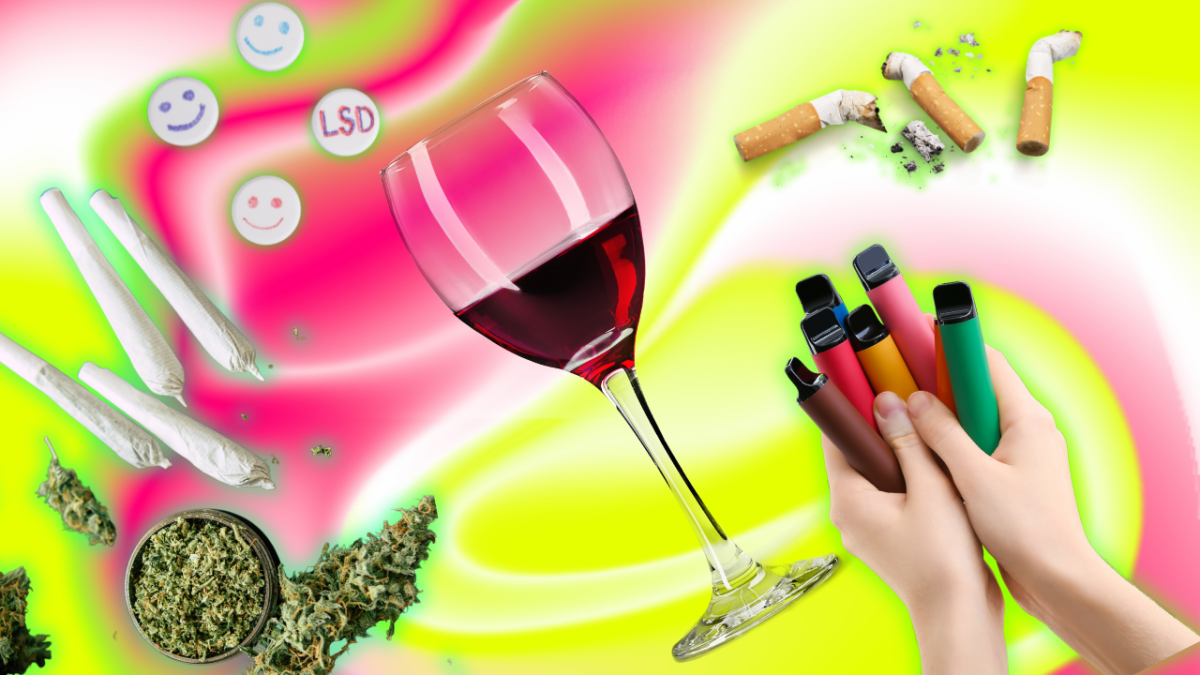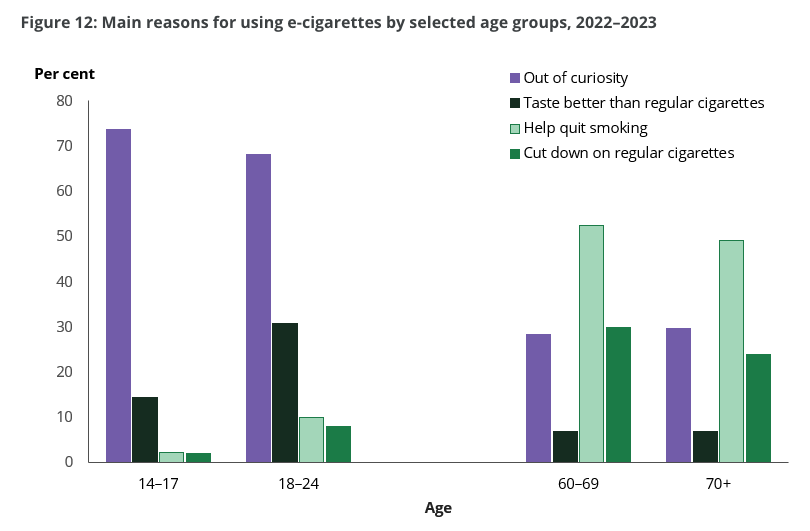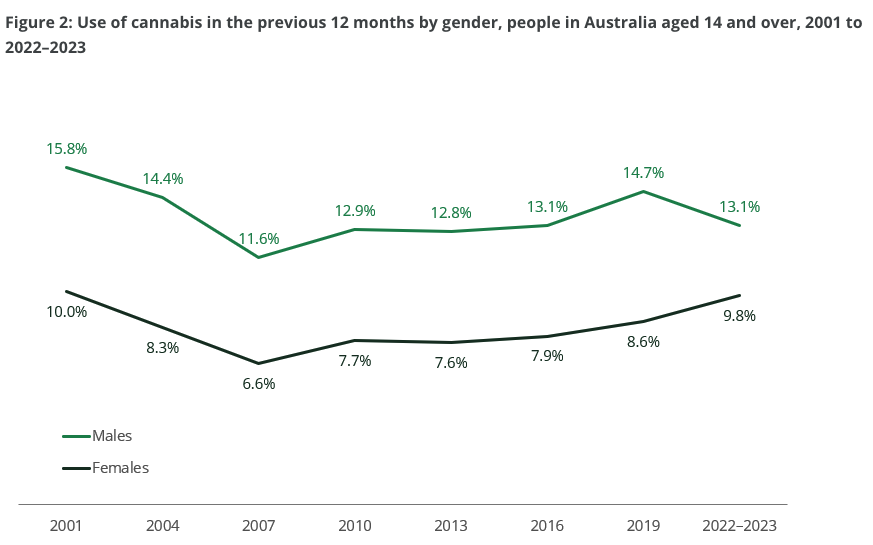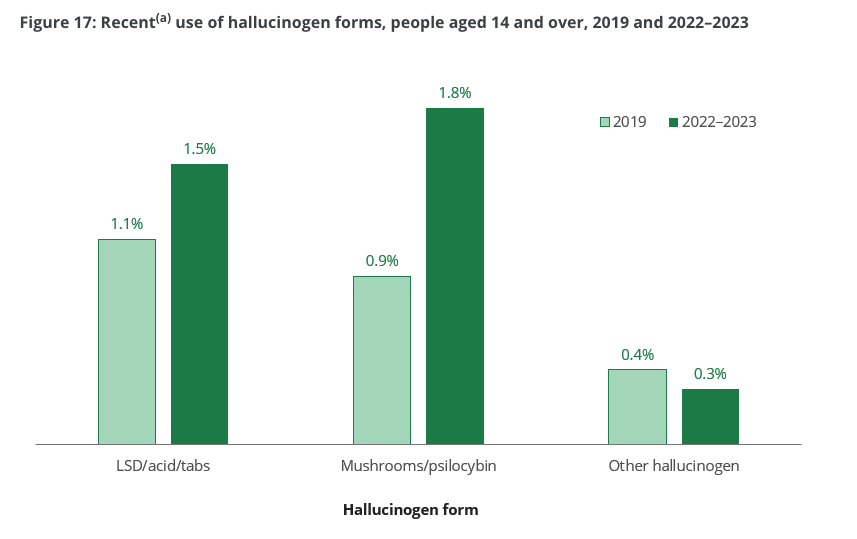
We’ve suspected for a while that young people are drinking less than previous generations and vaping more, and now we’ve got the official data to back that up. However, it’s not as steep of a drop as you’d think. Young people — and young women in particular —who do drink seem to be doing so more frequently and in amounts that could risk their health, according the 2022-2023 National Drug Strategy Household Survey.
Every three years, the Australian Institute of Health and Welfare (AIHW) conducts a survey into the smoking, drinking and drug habits of Aussies of all ages and backgrounds. The results for the 2022-2023 report, which surveyed more than 21,000 people, are in — and they paint a pretty interesting picture of where we’re all at.
The survey found that between it’s previous report which came out in 2019 and its 2022-2023 survey, smoking rates dropped from 11% to 8.3% — the lowest rates of people smoking daily than ever before.
This drop occurred for most age groups, with daily smoking rates for people aged between 25–29 and 30–39 dropping below 10% for the first time. However, smoking rates remained stable in those aged 60 and above.
Considering that the AIHW found in 2021 that tobacco use is responsible for more deaths in Australia than alcohol and illicit drugs combined, this is certainly an interesting development. However, on the flip side, vaping has — unsurprisingly — been on a meteoric rise.
Vaping among young people has quadrupled, national drug survey finds
Between 2019 and 2022-2023, the proportion of people aged 14 and above using vapes and electronic cigarettes nearly tripled (from 2.5% to 7%).
If you break it down by age group, vaping and the use of e-cigarettes was even more prevalent: 21% of people aged 18–24 use vapes, which is quadruple the number from the 2019 survey (the proportion jumped from from 5.3% to 21%). Vaping increased more than five-fold among people aged 14–17, from 1.8% to 9.7%.
Interestingly, the reasons for why people use vapes greatly differed. Young people were more likely to try vapes out of curiosity, whereas older people were more likely to use them as a way to quit smoking cigarettes. Though, whether they were actually effective at that is another question.
“The number of older Australians quitting smoking has not shifted substantially, indicating that e-cigarettes are not the panacea for quitting that industry actors keep promising,” Associate Professor Michelle Jongenelis, Deputy Director of the Melbourne Centre for Behaviour Change, said.

Experts reckon the cost of living crisis might have something to do with how much we’re vaping.
“The rise in vaping among young people is likely influenced by significant cost savings,” Dr Jason Jiang from the Department of Public Health and Centre for Alcohol Policy Research at La Trobe University said.
“For instance, a daily smoker might spend approximately $14,000 a year, assuming a cost of $40 for popular cigarette brands each day, whereas a daily vaper could incur just $1,400 annually by using a few $80 vaping pens and purchasing 40 bottles of e-liquid at $20 each.”
Young people aren’t too keen on the grog —– but those that drink are doing it more frequently
Heaps of young people are either not drinking at all, or doing so infrequently. In 2022-2023, a huge 1 in 5, or 20%, of young people were drinking less often than monthly (up from 13.6% in 2001), and 16.3% had never had a full glass (up from 7.5% in 2001).
However, young people who do drink are appearing to do so more frequently than in previous years.
In 2019, young people aged 18–24 who drank alcohol were most likely to do so monthly. But in 2022–2023, young people were most likely to drink alcohol weekly — for the first time since 2010.

Almost half of young people (42%) who drink alcohol were also consuming it at risky levels in 2023-2023.
This is pretty consistent with previous years, until you break it down by gender: in 2022-2023, 45% of males were consuming alcohol at risky levels, compared to 40% of females. However, in 2019, 47% males were drinking at levels that risked their health, compared to young women at 35%. Which means more young women are taking part in risky drinking than before.
The survey also found more women are experiencing harm at the hands of other people’s drinking — and Dr Jiang believes this could be because of our post-pandemic world and the way it’s affected our alcohol consumption.
“With a shift towards more men consuming alcohol at home instead of in on-premise locations such as pubs, clubs, and other venues, there has been an increase in alcohol-related harms to women at home and a decrease in harms experienced by men in public settings,” he said.
Cannabis, cocaine and psychedelics are Aussies’ most used illicit drugs
In 2022–2023, 11.5% of people in Australia used cannabis in the previous 12 months, which — if you generalised this to the population — would equate to around 2.5 million people. This is pretty consistent with the previous survey in 2019, despite the legalisation of some amounts of cannabis possession in the ACT in 2020.
Despite roughly the same amount of people reported using cannabis in 2022-2023 as 2019, the proportion of people reporting having used it at some point in their life increased to 41% — the highest it’s been since the survey first started collecting this data in 2001.

Interestingly, the proportion of women using cannabis in ways that were deemed “high risk” more than doubled from 1.8% to 4.8%, whereas high risk use of cannabis among men remained stable.
The second most used illicit drug in Australia in 2022-2023 was cocaine, with 4.1% of people reporting to have used it — which equates to about 1 million people, if adjusted for the general population of Australia. Which is pretty consistent with previous surveys.
What is a marked change, though, is the huge increase in hallucinogens usage. In 2019, 300,000 people reported using hallucinogens. In 2022-2023, this number jumped to 500,000 people.
This is partially attributed to the sharp increase in people trying mushrooms — almost double amount of people who tried it in 2019 — but more people are doing LSD, too.

Experts reckon the increase in hallucinogens might be partially because of recent breakthroughs in medical studies treating some mental health conditions — but warned people to be careful about self-medicating.
“The increased popularity of psychedelic drugs is likely due to increased media hype regarding the potential for these drugs to be used to treat mental health conditions,” Dr Stephen Bright, Senior Lecturer in Addiction at Edith Cowan University, said.
“Last year the TGA announced that authorised psychiatrists can now prescribe these drugs to patients with treatment-resistant depression and PTSD. Given that these treatments are still very expensive and difficult to access, desperate people will do desperate things to treat their mental health conditions.
“However, without the support of trained professionals, Australians who attempt to treat their mental illness using illicit drugs could unwittingly make their mental health worse or place themselves at risk of harm from underground psychedelic treatment providers.”
Use of ketamine also increased from 0.9% in 2019 to 1.4% in 2022–2023, and was most likely to be used by people in their 20s. There was also a five-fold increase in the proportion of people in their 30s using ketamine between 2019 (0.5%) and 2022–2023 (2.5%).
In a role reversal, women are now more likely than men to use substances in ways that are damaging to their health — a marked change from previous years.
Women were more likely to drink alcohol in ways that were deemed a risk to their health (this is determined by how much someone drinks and how often), and this was also the case with vape and cannabis use. According to the survey, there’s an overall trend in increasing risky drug use behaviours among young women in particular.
While we’re in no position to tell anyone what to eat, drink or consume in any way, the results of the survey are certainly a reminder to be careful of our drug use and look after our bodies.
- If you need mental health support, or support involving substance misuse and addiction, please call Lifeline on 13 11 14 or chat online.
- You can also reach the Alcohol Drug Information Service at 1800 250 015 or chat online.
- You can find helplines and resources at DrinkWise.
- Under 25? You can reach Kids Helpline at 1800 55 1800 or chat online.
- If you require immediate assistance, please call 000.



